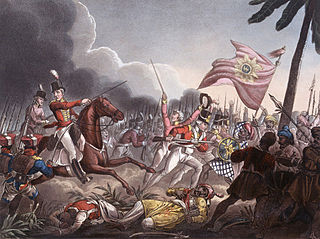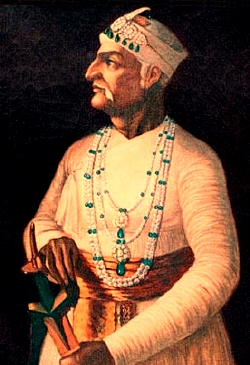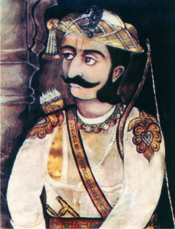
The Maratha Confederacy, also referred to as the Maratha Empire or the Maratha Kingdom, was an early modern polity in the Indian subcontinent comprising the realms of the Peshwa and four independent Maratha chiefs who were often subordinate to the former. It was formed in 1674 with the coronation of Shivaji of the House of Bhonsle as the Chhatrapati of the Marathas. The Maratha realm was recognised by Bahadur Shah I, the Shahenshah of Hindustan as a tributary state in 1707 after a prolonged rebellion. The Marathas continued to recognise the Shahenshah as their nominal suzerain similar to other contemporary Indian entities.

The Battle of Assaye was a major battle of the Second Anglo-Maratha War fought between the Maratha Empire and the British East India Company. It occurred on 23 September 1803 near Assaye in western India. An outnumbered Indian and British force, under the command of Major General Arthur Wellesley, defeated the combined Maratha army of Daulatrao Scindia and the Bhonsle Raja of Berar. The battle was Wellesley's first major victory and the one he later described as his finest accomplishment on the battlefield, even more so than his more famous victories in the Peninsular War, and his defeat of Napoleon Bonaparte at the Battle of Waterloo.

The Second Anglo-Maratha War (1803–1805) was a large conflict within the Maratha Confederacy involving the British East India Company. It resulted in major loss of territory for the Marathas, including regions around Delhi and in present-day Gujarat falling into direct Company rule.

Mirza Nasir-ud-Din Muḥammad Shah was the thirteenth Mughal emperor from 1719 to 1748. He was son of Khujista Akhtar, the fourth son of Bahadur Shah I. After being chosen by the Sayyid Brothers of Barha, he ascended the throne at the young age of 16, under their strict supervision.

Berar Province, also known as the Hyderabad Assigned Districts, was a province of Hyderabad. After 1853, it was administered by the British, although the Nizam retained formal sovereignty over the province. Azam Jah, the eldest son of the 7th Nizam, held the title of Mirza-Baig ("Prince") of Berar.

Nizam of Hyderabad was the title of the ruler of Hyderabad State. Nizam is a shortened form of Niẓām ul-Mulk, which means Administrator of the Realm, and was the title bestowed upon Asaf Jah I when he was appointed Viceroy of the Deccan by the Mughal Emperor Farrukhsiyar. In addition to being the Mughal Viceroy (Naib) of the Deccan, Asaf Jah I was also the premier courtier of the Mughal Empire until 1724, when he established the independent monarchy of Hyderabad and adopted the title "Nizam of Hyderabad".

Balaji Baji Rao, often referred to as Nana Saheb I, was the 8th Peshwa of the Maratha Confederacy. He was appointed as Peshwa in 1740 upon the death of his father, the Peshwa Bajirao I.

Madhavrao I (1745−1772) was the son of Peshwa Balaji Bajirao and grandson of Peshwa Bajirao I who served as 9th Peshwa of the Maratha Confederacy. During his tenure, the Maratha Confederacy recovered from the losses they suffered during the Third Battle of Panipat, an event known as Maratha Resurrection.

Mirza Nizam Ali Khan Siddiqi, Asaf Jah II was the 5th Nizam of Hyderabad State in South India between 1762 and 1803. He was born on 7 March 1734 as fourth son to Asaf Jah I and Umda Begum. His official name is Asaf Jah II, Nizam ul-Mulk, Nizam ud-Daula, Nawab Mir Nizam 'Ali Khan Siddiqi, Fateh Jang, Sipah Salar, Nawab Subedar of the Deccan. Sawānih-i-Deccan, a Persian work compiled by Munim Khan, a military commander during the era of Asaf Jah II gave more insight about administration of Asaf Jahis.

Mahadaji Shinde, later known as Mahadji Scindia or Madhava Rao Scindia, was a Maratha statesman and general who served as the Raja of Gwalior from 1768 to 1794. He was the fifth and the youngest son of Ranoji Rao Scindia, the founder of the Scindia dynasty. He is reputed for having restored the Maratha rule over North India and for modernizing his army.

Shrimant Daulat Rao Shinde was the Maharaja (ruler) of Gwalior state in central India from 1794 until his death in 1827. His reign coincided with struggles for supremacy within the Maratha Empire, and wars with the expanding East India Company. Daulatrao played a significant role in the Second and Third Anglo-Maratha wars.

Raghoji I or Raghuji the Great, was a Maratha general of the Bhonsle dynasty who established the Nagpur Kingdom in much of east-central India during the reign of Chhatrapati Shahu I. His successors ruled the kingdom until 1853.

Chakrāvarti Yashwant Rao Holkar (1776–1811) also known as Jaswantrao Holkar belonging to the Holkar dynasty of the Maratha Confederacy was the Maharaja of the Indore. He was a gifted military leader and educated in accountancy as well as literate in Persian and Marathi and Urdu.

Raghuji II or Raghuji was the Maratha ruler of the Kingdom of Nagpur in Central India from 1788 to 1816.

Narnala Fort or Narnala Qila Sarkar, also known as Shahnoor Fort, is a hill fortress in the Satpura Range of Vidarbh, Maharashtra, India, named after the Rajput Solanki Chaulukya Ruler, Raja Narnal Singh, also known as Narnal Singh Swami. It was renamed as "Shahnoor" by Islamic rulers but again acquired, rebuilt and got its name "Narnala" by ruler Rao Rana Narnal Singh Solanki, who migrated from Patan in Gujarat.
The Battle of Rakshasbhuvan in India was fought on 10 August 1763. After the defeat of the Maratha Confederacy at the Battle of Panipat, their rivals started seizing the opportunity to recover their losses in the past at the hands of Marathas. Particularly, the Nizam of Hyderabad wanted to recover territory he had lost at the Battle of Udgir. He decided to launch a war on the Marathas.

The Siege of Trichinopoly was part of an extended series of conflicts between the Nizam of Hyderabad and the Maratha Empire for control of the Carnatic region. On 29 August 1743, after a six-month siege, Murari Rao surrendered, giving Nizam ul Mulk (Nizam) the suzerainty of Trichinopoly. By the end of 1743, the Nizam had regained full control of Deccan. This stopped the Maratha interference in the region and ended their hegemony over the Carnatic. The Nizam resolved the internal conflicts among the regional hereditary nobles (Nawabs) for the seat of governor (Subedar) of Arcot State, and monitored the activities of the British East India company and French East India Company by limiting their access to ports and trading.
Amrut Rao was a Maratha noble, and the adopted son of Peshwa Raghunath Rao, who is also known as the First Maharaja of Karwi. In 1803, Yashwant Rao Holkar invaded his master's residence in Pune to resettle his dispute with Sindhiya, while Peshwa was out of city. Subsequently, Holkar set up an ad hoc council nominally headed by Amrut Rao, to punish Sindhiya and reassert his claims on Malwa. However, Baji Rao sought assistance from the British East India Company, whose advance forced Amrut Rao to flee Pune and make peace with Baji Rao Subsequently, Amrut Rao signed a treaty with the British, agreeing to give up all claims over the Peshwa's office in return for a pension and an estate in Peshwa Jagir of Bundelkhand.

The Nizam's Carnatic campaigns (1725–27) were a series of military campaigns of the Nizam of Hyderabad against the Maratha Empire and the Thanjavur Maratha Kingdom. These campaigns were sparked by the Maratha's attempts to collect taxes from the Nizam's dominions in Carnatic, leading to a conflict over control and revenue.
Khwaja Kamal, commonly known as Iwaz Khan, was a Turani Mughal leader who served as the last Subahdar of the Berar Subah under the Mughal empire. He also held the distinction of being the first Dewan of the Nizam of Hyderabad.



















